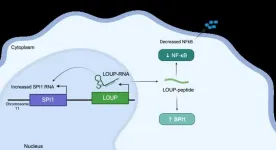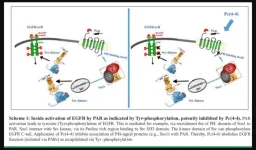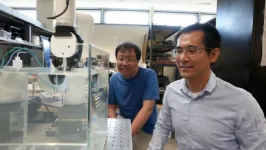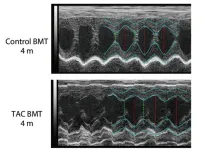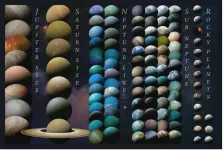(Press-News.org) UC Santa Cruz researchers have discovered a peptide in human RNA that regulates inflammation and may provide a new path for treating diseases such as arthritis and lupus. The team used a screening process based on the powerful gene-editing tool CRISPR to shed light on one of the biggest mysteries about our RNA–the molecule responsible for carrying out genetic information contained in our DNA.
This peptide originates from within a long non-coding RNA (lncRNA) called LOUP. According to the researchers, the human genome encodes over 20,000 lncRNAs, making it the largest group of genes produced from the genome. But despite this abundance, scientists know little about why lncRNAs exist or what they do. This is why lncRNA is sometimes referred to as the "dark matter of the genome."
The study, published May 23 in the Proceedings of the National Academy of Sciences (PNAS), is one of the very few in the existing literature to chip away at the mysteries of lncRNA. It also presents a new strategy for conducting high-throughput screening to rapidly identify functional lncRNAs in immune cells. The pooled-screen approach allows researchers to target thousands of genes in a single experiment, which is a much more efficient way to study uncharacterized portions of the genome than traditional experiments which focus on one gene at a time.
The research was led by immunologist Susan Carpenter, a professor and Sinsheimer Chair of UC Santa Cruz's Molecular, Cell, and Developmental Biology Department. She studies the molecular mechanisms involved in protection against infection. Specifically, she focuses on the processes that lead to inflammation to determine the role that lncRNAs play in these pathways.
"Inflammation is a central feature of just about every disease," she said. "In this study, my lab focused on trying to determine which lncRNA genes are involved in regulating inflammation."
This meant studying lncRNAs in a type of white blood cell known as a monocyte. They used a modification of the CRISPR/Cas9 technology, called CRISPR inhibition (CRISPRi), to repress gene transcription and find out which of a monocyte's lncRNAs play a role in whether it differentiates into a macrophage—another type of white blood cell that's critical to a well-functioning immune response.
In addition, the researchers used CRISPRi to screen macrophage lncRNA for involvement in inflammation. Unexpectedly, they located a region that is multifunctional and can work as an RNA as well as containing an undiscovered peptide that regulates inflammation.
Understanding that this specific peptide regulates inflammation gives drugmakers a target to block the molecular interaction behind that response in order to suppress it, Carpenter said. "In an ideal world, you would design a small molecule to disrupt that specific interaction, instead of, say, targeting a protein that might be expressed throughout the body," she explained. "We're still a long way from targeting these pathways with that level of precision, but that’s definitely the goal. There's a lot of interest in RNA therapeutics right now."
Co-authors of the study from UC Santa Cruz include Haley Halasz, Eric Malekos, Sergio Covarrubias, Samira Yitiz, Christy Montano, Lisa Sudek, and Sol Katzman, along with researchers at UCSF and MIT. The research was supported with funding from the National Institute of General Medical Sciences (R35GM137801 to Carpenter) and the National Institute of Allergy and Infectious Diseases (F31AI179201 to Malekos).
END
Tiny target discovered on RNA to short-circuit inflammation, UC Santa Cruz researchers find
New study details high-throughput process for rapid screening, identification of mysterious ‘long non-coding RNA’
2024-05-24
ELSE PRESS RELEASES FROM THIS DATE:
Charge your laptop in a minute? Supercapacitors can help; new research offers clues
2024-05-24
Imagine if your dead laptop or phone could charge in a minute or if an electric car could be fully powered in 10 minutes.
While not possible yet, new research by a team of CU Boulder scientists could potentially lead to such advances.
Published today in the Proceedings of the National Academy of Sciences, researchers in Ankur Gupta’s lab discovered how tiny charged particles, called ions, move within a complex network of minuscule pores. The breakthrough could lead to the development of more efficient energy storage devices, such as supercapacitors, said Gupta, an assistant professor of chemical and biological engineering.
“Given the critical role ...
Scientists discover CO2 and CO ices in outskirts of solar system
2024-05-24
ORLANDO, May 24, 2024 – For the first time, carbon dioxide and carbon monoxide ices have been observed in the far reaches of our solar system on trans-Neptunian objects (TNOs).
A research team, led by planetary scientists Mário Nascimento De Prá and Noemí Pinilla-Alonso from the University of Central Florida’s Florida Space Institute (FSI), made the findings by using the infrared spectral capabilities of the James Webb Space Telescope (JWST) to analyze the chemical composition of 59 trans-Neptunian objects and Centaurs.
The pioneering study, published ...
Theory and experiment combine to shine a new light on proton spin
2024-05-24
NEWPORT NEWS, VA – Nuclear physicists have long been working to reveal how the proton gets its spin. Now, a new method that combines experimental data with state-of-the-art calculations has revealed a more detailed picture of spin contributions from the very glue that holds protons together. It also paves the way toward imaging the proton’s 3D structure.
The work was led by Joseph Karpie, a postdoctoral associate in the Center for Theoretical and Computational Physics (Theory Center) at the U.S. Department of Energy's Thomas Jefferson National Accelerator Facility.
He said that this decades-old mystery began with measurements of the sources of the proton’s spin in ...
PKMYT1, a potential ‘Achilles heel’ of treatment resistant ER+ breast cancers with the poorest prognosis
2024-05-24
Up to 80% of breast cancer deaths occur in patients with tumors that express estrogen receptor-alpha. Although these estrogen receptor-positive (ER+) breast cancers often initially respond to standard treatment that combines endocrine therapies with CDK4/6 inhibitors, drug resistance often develops leading to lethal metastatic disease that spreads from the breast and does not respond to available treatments.
Looking to identify new vulnerabilities in this type of cancer that could lead to improved therapies, ...
PH-binding motifs as a platform for drug design: Lessons from protease-activated receptors (PARs)
2024-05-24
“We have identified binding motifs within the C-tails of PAR1,2&4, indispensable for cancer growth and development.”
BUFFALO, NY- May 24, 2024 – A new editorial paper was published in Oncoscience (Volume 11) on April 25, 2024, entitled, “PH-binding motifs as a platform for drug design: Lessons from protease-activated receptors; PARs.”
While targeted cancer therapy is greatly dependent on specific oncogenic pathways or conferred by genetic alterations, it remains yet challenging and somewhat disappointing. The high level of failure relies ...
Virginia Tech researcher creates new tool to move tiny bioparticles
2024-05-24
Undergoing surgery is seldom a pleasant experience, and it can sometimes be highly invasive. Surgical procedures have evolved steadily over the centuries, growing with the knowledge of anatomy and biology.
Innovative methods have also been bolstered with new tools, and a growth in the use of robotics since the 1980s has moved health care forward significantly. Assistant Professor Zhenhua Tian has pressed forward another step in the march of progress using robotics and noninvasive acoustics, and his team’s work has been published in Science Advances.
Robot-assisted surgery
Surgery using robots has been invasive since its invention because ...
On repeat: Biologists observe recurring evolutionary changes, over time, in stick insects
2024-05-24
LOGAN, UTAH, USA – A long-standing debate among evolutionary scientists goes something like this: Does evolution happen in a predictable pattern or does it depend on chance events and contingency? That is, if you could turn back the clock, as celebrated scientist Stephen Jay Gould (1941-2002) described in his famous metaphor, “Replaying the Tape of Life,” would life on Earth evolve, once again, as something similar to what we know now, or would it look very, very different?
“If you frame it as an either/or question, it’s too simplistic,” says Utah State University evolutionary biologist Zachariah Gompert. “The answer isn’t ‘completely ...
Understanding a broken heart
2024-05-24
The stress of heart failure is remembered by the body and appears to lead to recurrent failure, along with other related health issues, according to new research. Researchers have found that heart failure leaves a “stress memory” in the form of changes to the DNA modification of hematopoietic stem cells, which are involved in the production of blood and immune cells called macrophages. These immune cells play an important role in protecting heart health. However, a key signaling pathway (a chain of molecules which ...
Genetic cause of rare childhood immune disorders discovered
2024-05-24
Scientists have pinpointed genetic changes that can leave children born with little to no immune defence against infection.
In a new study of 11 affected individuals, researchers from Newcastle University, the Wellcome Sanger Institute, the Great North Children’s Hospital, and their collaborators were able to link mutations in the NUDCD3 gene to Severe Combined Immunodeficiency and Omenn syndrome1 – rare and life-threatening immunodeficiency disorders. These mutations prevented the normal development of diverse immune cells needed to combat different pathogens2.
The findings, published today (24 May) in Science Immunology, ...
With wobbling stars, astronomers gauge mass of 126 exoplanets and find 15 new ones
2024-05-24
LAWRENCE — Using data from the Transiting Exoplanet Survey Satellite and W.M. Keck Observatory on Mauna Kea in Hawaii, an astronomer at the University of Kansas led a study appearing today revealing 15 new exoplanets — planets beyond our solar system — along with the mass of 126 other exoplanets. The findings give astronomers new understanding of the makeup of exoplanets and their star systems generally.
The study cataloging the exoplanets — comprising severe and exceptional environments, some of which hold promise to support life — was conducted under auspices of the TESS-Keck Survey and appears ...
LAST 30 PRESS RELEASES:
Numbers in our sights affect how we perceive space
SIMJ announces global collaborative book project in commemoration of its 75th anniversary
Air pollution exposure and birth weight
Obstructive sleep apnea risk and mental health conditions among older adults
How talking slows eye movements behind the wheel
The Ceramic Society of Japan’s Oxoate Ceramics Research Association launches new international book project
Heart-brain connection: international study reveals the role of the vagus nerve in keeping the heart young
Researchers identify Rb1 as a predictive biomarker for a new therapeutic strategy in some breast cancers
Survey reveals ethical gaps slowing AI adoption in pediatric surgery
Stimulant ADHD medications work differently than thought
AI overestimates how smart people are, according to HSE economists
HSE researchers create genome-wide map of quadruplexes
Scientists boost cell "powerhouses" to burn more calories
Automatic label checking: The missing step in making reliable medical AI
Low daily alcohol intake linked to 50% heightened mouth cancer risk in India
American Meteorological Society announces Rick Spinrad as 2026 President-Elect
Biomass-based carbon capture spotlighted in newly released global climate webinar recording
Illuminating invisible nano pollutants: advanced bioimaging tracks the full journey of emerging nanoscale contaminants in living systems
How does age affect recovery from spinal cord injury?
Novel AI tool offers prognosis for patients with head and neck cancer
Fathers’ microplastic exposure tied to their children’s metabolic problems
Research validates laboratory model for studying high-grade serous ovarian cancer
SIR 2026 delivers transformative breakthroughs in minimally invasive medicine to improve patient care
Stem Cell Reports most downloaded papers of 2025 highlight the breadth and impact of stem cell research
Oxford-led study estimates NHS spends around 3% of its primary and secondary care budget on the health impacts of heat and cold in England
A researcher’s long quest leads to a smart composite breakthrough
Urban wild bees act as “microbial sensors” of city health.
New study finds where you live affects recovery after a hip fracture
Forecasting the impact of fully automated vehicle adoption on US road traffic injuries
Alcohol-related hospitalizations from 2016 to 2022
[Press-News.org] Tiny target discovered on RNA to short-circuit inflammation, UC Santa Cruz researchers findNew study details high-throughput process for rapid screening, identification of mysterious ‘long non-coding RNA’
